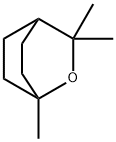1,4-Cineole
Synonym(s):1-Isopropyl-4-methyl-7-oxabicyclo[2.2.1]heptane
- CAS NO.:470-67-7
- Empirical Formula: C10H18O
- Molecular Weight: 154.25
- MDL number: MFCD00209502
- EINECS: 207-428-9
- SAFETY DATA SHEET (SDS)
- Update Date: 2024-12-18 14:07:02

What is 1,4-Cineole?
Chemical properties
1,4-Cineole has a light and mild camphoraceous odor and a cool, mildly spice-like flavor.
Occurrence
Reported present in Piper cubeba, lime peel oil, apricot, cardamom (Eleteria cardamomun Maton), orange juice, grapefruit juice, laurel (Laurus nobilis L), rosemary and mastic gum leaf oil. It is also present in various essential oils; Boldea fragrans Juss., Xanthoxylum rhetsa D.C. and Ormenis multicaulis.
The Uses of 1,4-Cineole
Apart from the academic interest related to the olfactory similarity or dissimilarity) of isomer chemicals, there is not much interest in this chemical. It is not nearly as readily available as its isomer, Eucalyptol.
Definition
ChEBI: 1,4-cineole is an oxabicycloalkane consisting of p-menthane with an epoxy bridge across positions 1 and 4. It has a role as a plant metabolite, a fumigant insecticide and a central nervous system depressant. It is a cineole and an oxabicycloalkane.
Taste threshold values
Taste characteristics at 40 ppm: cooling, minty, menthol-like, green and herbal, with a terpy and camphoraceous nuance.
General Description
1,4-Cineole is present in eucalyptus oil. It activated both human TRPA1 (a sensor of noxious cold) and human TRPM 8 (a thermosensitive receptor). It is a natural monoterpene that inhibits plant growth.
Synthesis
Its structure has been confirmed through synthesis.*
Properties of 1,4-Cineole
| Melting point: | -46 °C (lit.) |
| Boiling point: | 65 °C/16 mmHg (lit.) |
| Density | 0.887 g/mL at 25 °C (lit.) |
| refractive index | n |
| FEMA | 3658 | 1,4-CINEOLE |
| Flash point: | 118 °F |
| storage temp. | Store at -20°C |
| Water Solubility | Slightly soluble in water |
| solubility | Almost insoluble in water, soluble in alcohol and oils. DMSO: 125 mg/mL (810.37 mM) |
| form | Liquid |
| form | neat |
| color | Colorless to Almost colorless |
| Odor | Cool, somewhat spicy-herbaceous taste |
| JECFA Number | 1233 |
| BRN | 104974 |
| CAS DataBase Reference | 470-67-7(CAS DataBase Reference) |
| NIST Chemistry Reference | 7-Oxabicyclo[2.2.1]heptane, 1-methyl-4-(1-methylethyl)-(470-67-7) |
| EPA Substance Registry System | 1,4-Cineole (470-67-7) |
Safety information for 1,4-Cineole
| Signal word | Warning |
| Pictogram(s) |
 Flame Flammables GHS02 |
| GHS Hazard Statements |
H226:Flammable liquids |
| Precautionary Statement Codes |
P210:Keep away from heat/sparks/open flames/hot surfaces. — No smoking. P370+P378:In case of fire: Use … for extinction. |
Computed Descriptors for 1,4-Cineole
New Products
Tert-butyl bis(2-chloroethyl)carbamate 4-Methylphenylacetic acid N-Boc-D-alaninol N-BOC-D/L-ALANINOL N-octanoyl benzotriazole 3-Morpholino-1-(4-nitrophenyl)-5,6-dihydropyridin- 2(1H)-one Furan-2,5-Dicarboxylic Acid DIETHYL AMINOMALONATE HYDROCHLORIDE 1,1’-CARBONYLDIIMIDAZOLE R-2-BENZYLOXY PROPIONIC ACID 1,1’-CARBONYLDI (1,2-4 TRIAZOLE) N-METHYL INDAZOLE-3-CARBOXYLIC ACID (2-Hydroxyphenyl)acetonitrile 4-Bromopyrazole 5-BROMO-2CYANO PYRIDINE 5,6-Dimethoxyindanone 5-broMo-2-chloro-N-cyclopentylpyriMidin-4-aMine 2-(Cyanocyclohexyl)acetic acid 4-methoxy-3,5-dinitropyridine 1-(4-(aminomethyl)benzyl)urea hydrochloride 2-aminopropyl benzoate hydrochloride diethyl 2-(2-((tertbutoxycarbonyl)amino) ethyl)malonate tert-butyl 4- (ureidomethyl)benzylcarbamate Ethyl-2-chloro((4-methoxyphenyl)hydrazono)acetateRelated products of tetrahydrofuran








You may like
-
 1,4-Cineole CAS 470-67-7View Details
1,4-Cineole CAS 470-67-7View Details
470-67-7 -
 1,4-Cineole CAS 470-67-7View Details
1,4-Cineole CAS 470-67-7View Details
470-67-7 -
 1,4-Cineole CAS 470-67-7View Details
1,4-Cineole CAS 470-67-7View Details
470-67-7 -
 1975-50-4 98%View Details
1975-50-4 98%View Details
1975-50-4 -
 2-HYDROXY BENZYL ALCOHOL 98%View Details
2-HYDROXY BENZYL ALCOHOL 98%View Details
90-01-7 -
 14714-50-2 (2-Hydroxyphenyl)acetonitrile 98+View Details
14714-50-2 (2-Hydroxyphenyl)acetonitrile 98+View Details
14714-50-2 -
 118753-70-1 98+View Details
118753-70-1 98+View Details
118753-70-1 -
 733039-20-8 5-broMo-2-chloro-N-cyclopentylpyriMidin-4-aMine 98+View Details
733039-20-8 5-broMo-2-chloro-N-cyclopentylpyriMidin-4-aMine 98+View Details
733039-20-8